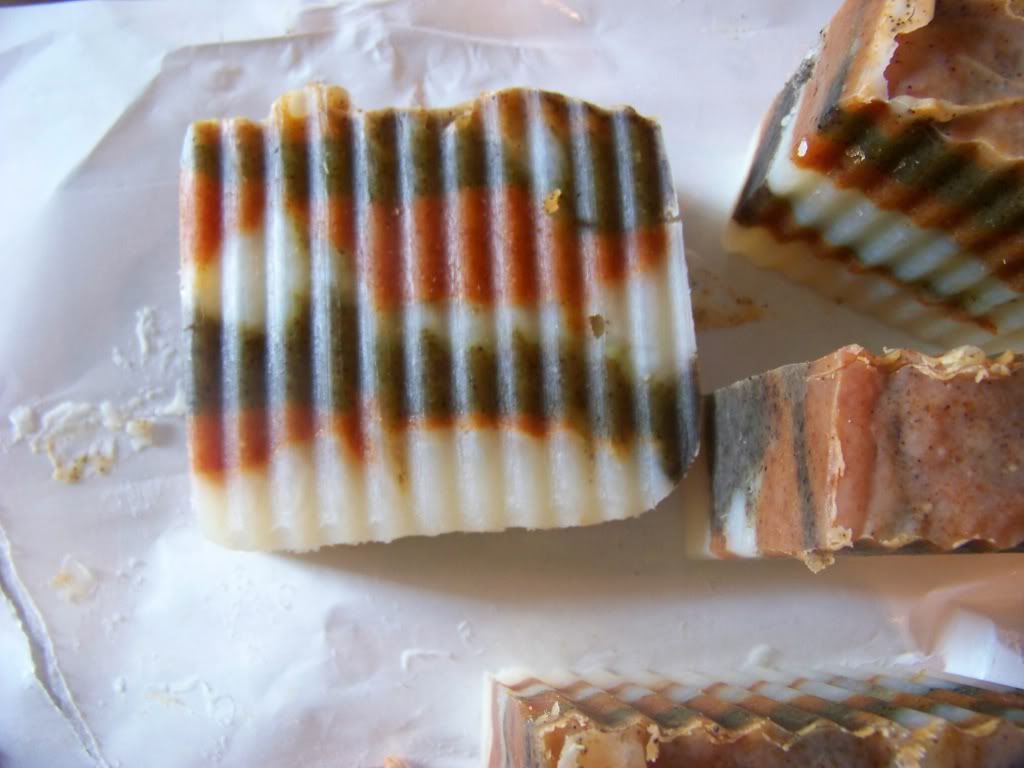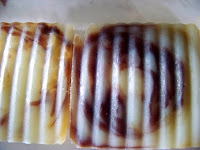Line a baking pan (9x9) with foil, making sure that the foil goes all the way up the sides of the pan, or you will be sorry! Then, butter the sides of a 2 quart saucepan. Combine the corn syrup, sugar, honey, and water in the pan. Cook over a medium-high heat until the mixture boils. Make sure that you stir constantly, in order to dissolve the sugar and keep it from burning. This usually takes about five minutes, give or take a few minutes. Once the sugar is dissolved, turn the heat down to medium and continue cooking at a light boil. Stir occasionally. Once it reaches the soft crack stage (which is 290 degrees F. on a candy thermometer), keep cooking for 20 more minutes, still stirring occasionally.
Remove from the heat and allow to cool. Stir it occasionally, as it cools, for the next 2-3 minutes, then add the lemon. **If you are going to add any other vitamins or herbs, add them at this point** Then pour the mixture into the foil-lined pan to finish cooling. As it cools (another 3-10 minutes), it is a good idea to use a spatula and mark some "break" lines into the drops. Make squares in the size you want, remembering that they are for individual-size portions. These marks will stay when the mixture is completely set up, making it easier to portion correctly and consistently. If your marks do not stay, it means that the mixture is still too hot and needs more cooling time, just wait a while and try it again. Once properly marked, let the pan sit overnight then use the foil to lift it out of the pan. Break the pieces apart along your marks then package them in individual candy wrappers or wax paper. Make sure to twist each end tightly, then put all of the wrapped pieces into a large baggie or a paper bag. This recipe will make from 100-200 pieces, depending upon the size that you mark and break. They will last from 6-8 months, when properly wrapped and stored.
**To make this recipe more holistic and herbal you can add one each of the
following; zinc, vitamin C, echinacea, and goldenseal. If these are in tablet form, finely crush them before adding, if in capsules, just pull apart and drop the inner content into your mixture.
Of course you could also change up this recipe by either substituting (for the lemon), or just by adding an herb or two (some essential oils are ok too) to the lemon.
*when using fresh herbs, it is probably best to infuse them into the liquid portion of the recipe, but you can also finely chop them.
*You may also substitute a food-safe flavoring oil, however you will NOT receive any of the benefits listed for that flavor. The way in which they are created destroys their natural benefits.
*If you plan to use essential oils, you MUST be aware of, and familiar with, the warnings, as well as the necessary dilution rate (which are not provided for you here).
*If you are not familiar with the proper use of essential oils in edible products, you should NOTattempt to use them in this recipe.
If you want, you may add another herb/spice (in addition) to the lemon. Basil, bay, bergamot, black pepper, clary sage, geranium, grapefruit, lavender, lime, orange, rosemary, vanilla, all blend well with lemon. If you would like to substitute another herb/spice for the lemon, you may want to consider one of the following;
-Basil has a beneficial action on the respiratory tract, and is often used for asthma, bronchitis, colds, coughs and sinus infections. It blends well with; black pepper, ginger, geranium, grapefruit, lavender and lemon.
-Black Pepper has antimicrobial and antiseptic properties, and is good for coughs, colds and flus. It blends well with bergamot, clary sage, coriander, fennel, geranium, ginger, grapefruit, lavender, lemon, lemongrass, lime, orange, nutmeg, and rosemary.
-Ginger is good for colds and flu, congestion, coughs, sinusitis, sore throats, fever and chills. It does have a slight warming affect, so be extra cautious in the amount that you add. It blends well with; basil, black pepper, cinnamon, clary sage, clove, coriander, eucalyptus, geranium, lemon, lime, orange, rose, rosemary, spearmint, and vanilla.
-Geranium is good for sore throats and tonsillitis, and blends well with; basil, grapefruit, lavender, lime, orange, and rosemary.
-Grapefruit is good for colds, flu, and headaches and blends well with; basil, black pepper, geranium, lavender, lime, and lemon.
-Lavender is good for bronchitis, asthma, colds, laryngitis, and throat infections. It will blends well with everything, so use your imagination.
-Lemongrass is good for sore throats, laryngitis, and fever as well as indigestion and gastroenteritis. It blends well with; basil, bergamot, black Pepper, clary Sage, eucalyptus, geranium, ginger, lavender, lemon, lime, mandarin, orange, rose, and vanilla.
-Lime is good fevers, colds, sore throats, flu, coughs, bronchitis, sinusitis and asthma. It blends well with; basil, clary sage, eucalyptus, geranium, ginger, grapefruit, lavender, lemon, lemongrass, orange, peppermint, rose, rosemary, and spearmint.
-Margoram, an antiseptic and calming agent
-Eucalyptus, an antiseptic and calming agent, good for bronchitis, colds, flu, headaches, sinusitis sore throats, and throat infections. The antiseptic properties in the essential oil increase with age.
-Orange (Sweet) is good for colds, flu, and fever, blending well with; basil, black Pepper, cinnamon, ginger, clary Sage, lavender, lime, peppermint, and spearmint.
-Peppermint, an antiseptic, expectorant and a muscle relaxant, so it is good for
dry coughs, sinus congestion, asthma, bronchitis, and pneumonia, as well as bad breath (in case you want to make breath drops along with the throat drops). Peppermint blends well with; basil, black pepper, eucalyptus, geranium, lavender, lemon, lime, orange, and rosemary.
-Rose (use pure essential oil or untreated rose petals to infuse the water) posses anti-infectious, antiseptic, antiviral, and bactericidal properties that help with asthma, headaches, and coughs. It blends well with; bergamot, chamomile, clary sage, geranium, lavender, lemon, and madarin.
-Rosemary is an antiseptic and works well for respiratory track issues, including asthma and bronchitis. It blends well with; basil, bay, black pepper, chamomile, geranium, ginger, grapefruit, lavender, lime, lemon, lemongrass, peppermint, rose and spearmint.
-Spearmint. While spearmint has properties of a local anesthetic, an antiseptic, a decongestant and an expectorant which can benefit fevers, headaches, asthma, bronchitis and colds, its effects are less powerful than those of peppermint. For this reason, spearmint may be better in children's products. It blends well with; basil, lavender, peppermint and rosemary.
-Thyme is frequently used in commercial applications of mouthwash, gargles, toothpastes and cough drops because of its analgesic, antifungal, anti-infectious, antimicrobial, anti-oxidant, and antiseptic properties. It is good for bronchitis, chills, colds, coughs, sinusitis, sore throats, tonsillitis, and laryngitis. It blends well with; bergamot, clary sage, eucalyptus, geranium, grapefruit, lavender, lemon, marjoram, and rosemary.
I am sure there are other additive that would also be helpful, but these are what came to mind.
BATH FIZZY for COLDS
This recipe will help with the symptoms of a cold as you soak in a nice warm bath.
You will need;
1/4 cup of baking soda
1/4 cup of powdered citric acid
a few drops of sweet almond oil or your choice of a similar oil
4 drops of an Essential Oil or EO blend
To make, simply mix the baking soda with the essential oil(s), and work it through until there are no clumps. You can use the back of a spoon to mash them out, or you can use a sifter to sift them out, or you can used a gloved hand, whichever way you prefer. Then add in the citric acid and begin squeezing it through your hands, working it like dough. You need to be gloved when doing this. Add oil by the drops as you work the ingredients together. When you have a consistency that holds together when its squished into a ball, you have it right. If the mix looks very dry, is crumbly, or falls apart, just add a bit more oil. Use caution though, you don't want to over-use oil, or you will cause the fizzy to not set up properly. If you start on the low end of oil addition, adding it by drops, you can always add more if/when you need it. While you can always add more, you can never take it back out!
Once everything is mixed, you can use it as is, or you can press it into a soap or candy mold to get a stylish shape. If you use a mold, you will want to overfill the mold cavity with your mix, then press it down hard, very hard. Once all the cavities are over-full, place a clean dishcloth over the entire mold, and place a book or two on top to apply pressure and to help it finish compressing into the mold. Leave it set up over night.
After they are set, hold the mold with both hands, and gently turn it upside down, close to the table top. With your thumbs, gently push the back of the filled cavity to release it. Don't let it hit the table hard, as it will break. These will last 3-6 months, but you don't want to mix up a large batch at any one given time, because the mix can react to moisture and get hard. To help avoid this possibility, store these in an airtight container.
Now, you probably thought that I forgot to give you the details of exactly which essential oils to use, but I didn't! I am going to list all of the ones that you could use, the ones that are [reported to be] beneficial for cold symptoms. then, you can choose which one or more that you want to add, depending upon what you have available, and what you like. If you are familiar with them, you can choose which ones work better for you and your current symptoms.
Please note that using essential oils for an ailment, or symptoms of ailments, is not approved by the FDA. This blog and its information is not intended to treat, prescribe, or in any way, replace the advice of your physician. The information provided in purely educational, and may be inaccurate and/or incomplete. Please see the disclaimer page tab at the top of this post for more detailed information on this matter.
This essential oil list is pretty lengthy. While they all have properties that are said to benefit stuffy heads and the various symptoms of a cold, I have keyed the oils, with letters, to identify oils that also have properties said to benefit particular symptoms associated with the issues referred to. A= asthma, B= bronchitis, CC= cough and cold, F= flu, and S= sinusitis
Clove-A
cedarwood-B
angelica root- B,CC
all spice- B,CC
cajeput-S
black pepper-cough
camphor-S
basil
bay
clary sage- whooping cough
citronella-F
cypress-A,B,cold
eucalyptus-A B C F (not for kids)
fennel- A B
Frankincense-A B CC F
ginger- cold, congestion, F
myrtle- A F
patchouli- congestion
myrrh- A B CC
grapefruit- cold and congestion
hyssop A B CC & whooping cough
jasmine- cough
lavender A F cold
lemon B F fever
lime A B F cold fever
marjoram head cold, congestion
peppermint F
pine A F cold
orange B cold
rose A
rosemary B CC
rosewood CC respiratory infection
sandalwood B cough
tea tree A CC S
red thyme A CC S
Certainly this list may not be all inclusive, it is just the culmination of years of my note taking....so it could also contain a mistake or two as well, but this is it to the best of my recollection! I hope you find it informative. There are certainly enough oils that you should be able to come up with a combination or two that you enjoy the scent of , and that may help relieve some of your cold symptoms.
Of course you should seek medical attention for any severe or lasting symptoms.

















